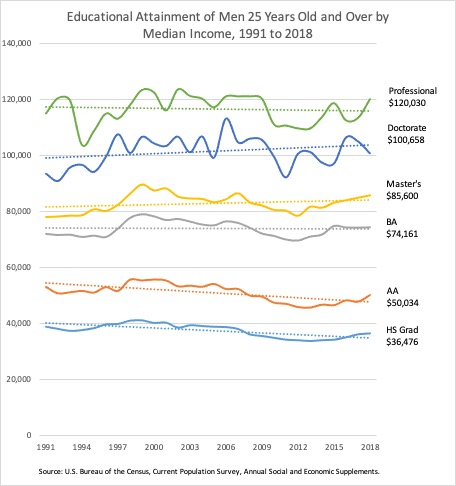Telling the Truth About Returns to Education
By Dr. Watson Scott Swail
I’ve documented the returns to education for several decades, in terms of personal, family, and household income. These data have been used largely to showcase the returns to a higher education and make the case that the cost of a college degree, especially a bachelor’s degree, is worth it.
Alas, it remains true that the return to a higher education, as compared to high school educated workers and less, is large. According to the College Board (below), the financial return, as measured by median family income, for a BA or higher double that of a high school diploma. This is an impressive statistic. [For full disclosure, I co-directly the Trends reports between 1997 and 2000.]

SOURCE: The College Board Trends in College Pricing 2019.
However, these data are somewhat misleading for several reasons. First, the data combine the bachelor’s degree with all advanced degree options, including master’s, doctoral, and professional degrees, which have far greater returns than the BA, essentially masking the true outcomes of the BA. Second, it uses family income as a measure rather than an individual indicator. Not necessarily a bad thing, but this really is about personal returns to education and should use those data accordingly. This is because, in part, a person with a BA or higher is much more likely to marry someone else with a college degree.[1] So there is a potential doubling of the earning power when using family income as a measure.
It is important to note that the percentage of those with less than a high school diploma, and even those with a high school diploma, represent a small percentage of the population. The sunburst chart below illustrates the distribution of people aged 16 and older and their highest education level. Only 15 percent of the population have less than a high school diploma (this includes some students still in college), and one quarter (27 percent) have an earned high school diploma or GED as their highest level of education. Thus, 42 percent have the diploma or GED or less, leaving 58 percent of the population with some level of college. Of this group, 20 percent have a BA, 18 percent “some” college, 9 percent an AA, 8 percent a master’s degree, (not labelled) 1 percent a professional degree and 2 percent a doctorate. Only three percent of this population have a degree beyond the master’s level.

SOURCE: Current Population Survey, Annual Social and Economic Supplement, 2018
This is important to understand. As the College Board’s data shows, those with a BA or higher earn, on median value, $121,000 as a family unit. What these data mask is that the biggest earners here have an advanced degree. To illustrate, I took the same data from the Census Bureau and broke it out. Here’s what I found:

This chart includes people who have a high school diploma or higher, noting that only a much smaller fraction have less than a HS diploma, which, in the previous chart, includes many high school students (those who are 17 and 18 and not in the workforce). As well, this chart uses personal income rather than family income. What we find is that the median personal income was $35,589 for all working aged (18 and above) people in 2017. Those with a HS diploma or GED earned $22,001, those with some college $23,694, and those with an AA $32,400. People with an earned BA received $47,003.
Important to remember is that advanced degrees earn far more than a BA, but represent only 11 percent of the population, including the professional and doctoral degree earners combining for only 3 percent of the population. The average returns for this group is approximately $87,000.
The story needs to be told over time, as well. Between 1991 and 2018 the income returns to education have remained almost flat at all levels. The chart below, using median income (constant 2018 dollars) for males (truncated only for visualization; women earn 35 percent less than men in this dataset), illustrates that the median earnings of those with BAs increased a total of 3 percent, as compared to 10 percent for master’s, 4 percent for professional, and 8 percent for doctorates. Median income by associate’s degrees declined 5 percent 6 percent high school graduates during this period. Given that this represents a 27-year period, these are fairly flat changes.

The takeaway is that there is more to the numbers than is sometimes characterized. There is a premium return to a higher education, but that return depends greatly on the level, as can be seen in several of these charts, and only a small percentage of people attain the highest earnings. The average—or even median—returns are much more modest. A quick note to remind people that the earnings of those with a BA are often for similar jobs that once required only a high school degree. Thus, some of the earning power of the high school diploma has been appropriated by the BA, resulting in lowering the returns accorded to the high school diploma.
[1] https://www.theatlantic.com/sexes/archive/2013/04/college-graduates-marry-other-college-graduates-most-of-the-time/274654/

